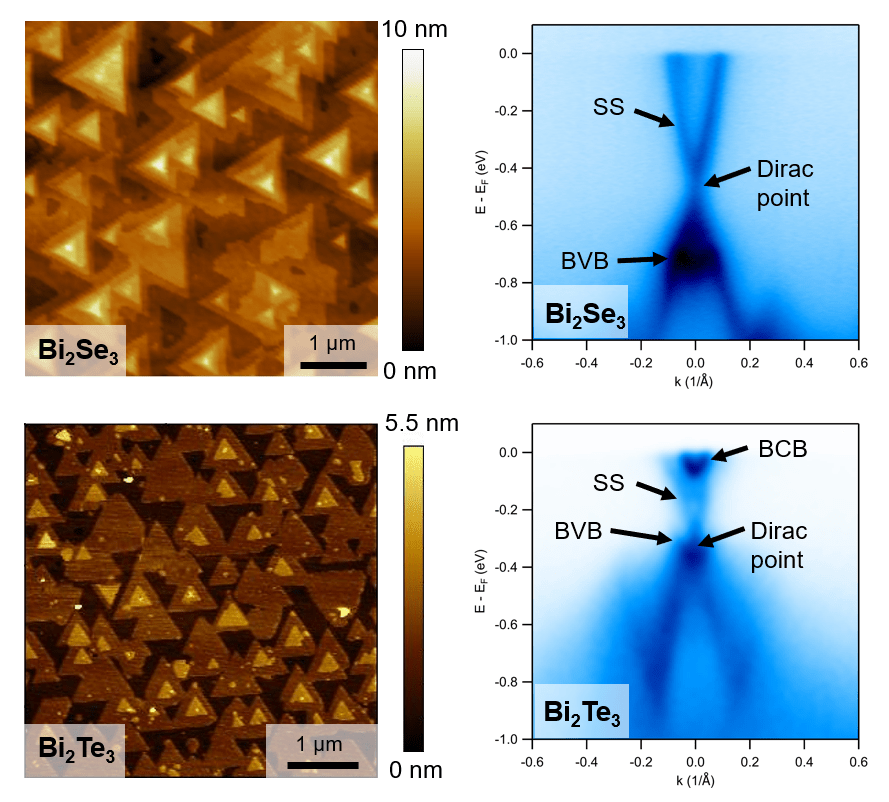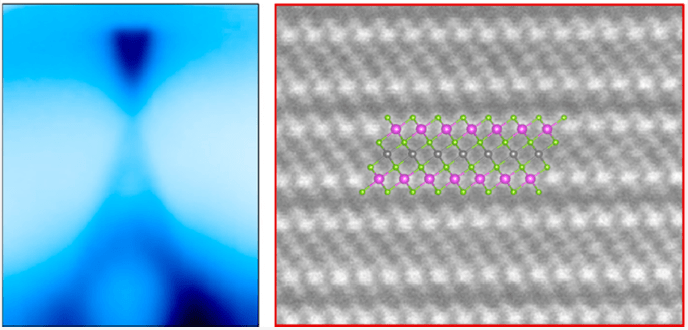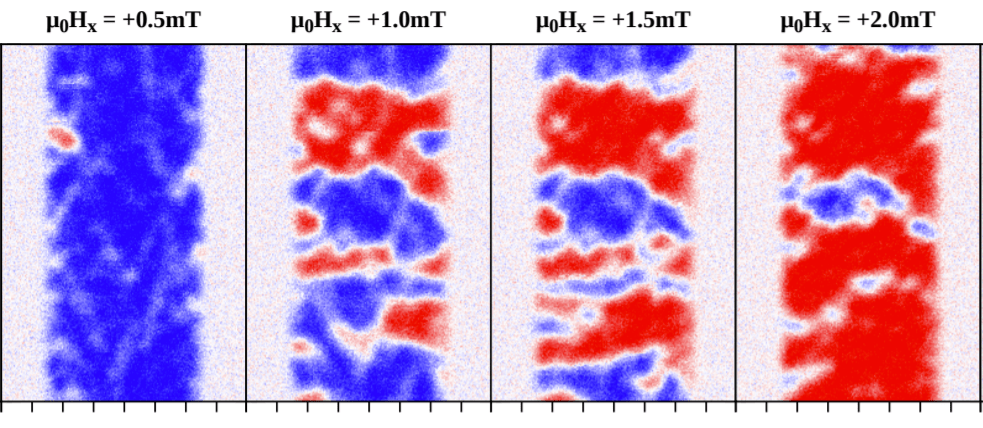In materials with strong spin-orbit coupling, new topological states can emerge in the surface, edge, and bulk regions. These states are characterized by topological invariants and are protected against various disorders. In addition, the spin-momentum locking observed in many of these states can lead to efficient spin-charge interconversion which is useful for spintronics devices and leads to efficient spin-orbit torque (see the related page on Spin-Orbit Torque and Magnetization Dynamics).
 Two-dimensional (2D) and three-dimensional (3D) topological insulators (TI) have topologically-protected edge states and surface states originating from Berry curvature typically generated by large spin-orbit coupling. Prototypical 2D TIs include HgCdTe quantum wells and monolayer WTe2 which exhibit the quantum spin Hall effect with helical edge states. Prototypical 3D TIs include Bi2Se3, Bi2Te3, Bi1-xSbx, and (Bi,Sb)2(Se,Te)3, which exhibit topological Dirac surface states with spin-momentum locking (to the left, see AFM and ARPES data from our materials). The addition of ferromagnetism to TIs produces additional topological states, most notably the quantum anomalous Hall effect with dissipationless edge states as observed in Cr-doped (Bi,Sb)2Te3 and in MnBi2Te4.
Two-dimensional (2D) and three-dimensional (3D) topological insulators (TI) have topologically-protected edge states and surface states originating from Berry curvature typically generated by large spin-orbit coupling. Prototypical 2D TIs include HgCdTe quantum wells and monolayer WTe2 which exhibit the quantum spin Hall effect with helical edge states. Prototypical 3D TIs include Bi2Se3, Bi2Te3, Bi1-xSbx, and (Bi,Sb)2(Se,Te)3, which exhibit topological Dirac surface states with spin-momentum locking (to the left, see AFM and ARPES data from our materials). The addition of ferromagnetism to TIs produces additional topological states, most notably the quantum anomalous Hall effect with dissipationless edge states as observed in Cr-doped (Bi,Sb)2Te3 and in MnBi2Te4.
Topological semimetals known as Dirac semimetals and Weyl semimetals have 3D Dirac cones within the bulk. Dirac semimetals have time-reversal and inversion symmetry leading to doubly-degenerate Dirac cones, while breaking these symmetries lifts the degeneracy in Weyl semimetals.
To probe the fascinating physics of these systems, our group focuses on the synthesis of topological materials by molecular beam epitaxy (MBE). We are especially interested in topological materials that incorporate magnetic order, as the topological states could be controlled by external magnetic fields and spin currents.
Highlights
Synthesis and Properties of MnBi2Se4, a Unique Magnetic Topological Insulator
 The intrinsic magnetic topological insulators MnBi2Te4 and MnBi2Se4 support novel topological states related to symmetry breaking by magnetic order. Unlike MnBi2Te4, the study of MnBi2Se4 has been inhibited by the lack of bulk crystals, as the van der Waals (vdW) crystal is not the thermodynamic equilibrium phase. In this study, we developed the layer-by-layer synthesis of vdW MnBi2Se4 crystals using non-equilibrium molecular beam epitaxy. Atomic-resolution scanning transmission electron microscopy and scanning tunneling microscopy identified a well-ordered vdW crystal with septuple-layer base units. Magnetic properties agreed with the predicted layered antiferromagnetic ordering but disagreed with its predicted out-of-plane orientation. Instead, our samples exhibited an easy-plane anisotropy, which is explained by including dipole-dipole interactions. Angle-resolved photoemission spectroscopy (ARPES) revealed the gapless Dirac-like surface state, which demonstrated that MnBi2Se4 is a topological insulator above the magnetic-ordering temperature. These studies show that MnBi2Se4 is a promising candidate for exploring rich topological phases of layered antiferromagnetic topological insulators. For more information, see Zhu et al., “Synthesis, Magnetic Properties, and Electronic Structure of Magnetic Topological Insulator MnBi2Se4,” Nano Letters 21, 5083–5090 (2021)
The intrinsic magnetic topological insulators MnBi2Te4 and MnBi2Se4 support novel topological states related to symmetry breaking by magnetic order. Unlike MnBi2Te4, the study of MnBi2Se4 has been inhibited by the lack of bulk crystals, as the van der Waals (vdW) crystal is not the thermodynamic equilibrium phase. In this study, we developed the layer-by-layer synthesis of vdW MnBi2Se4 crystals using non-equilibrium molecular beam epitaxy. Atomic-resolution scanning transmission electron microscopy and scanning tunneling microscopy identified a well-ordered vdW crystal with septuple-layer base units. Magnetic properties agreed with the predicted layered antiferromagnetic ordering but disagreed with its predicted out-of-plane orientation. Instead, our samples exhibited an easy-plane anisotropy, which is explained by including dipole-dipole interactions. Angle-resolved photoemission spectroscopy (ARPES) revealed the gapless Dirac-like surface state, which demonstrated that MnBi2Se4 is a topological insulator above the magnetic-ordering temperature. These studies show that MnBi2Se4 is a promising candidate for exploring rich topological phases of layered antiferromagnetic topological insulators. For more information, see Zhu et al., “Synthesis, Magnetic Properties, and Electronic Structure of Magnetic Topological Insulator MnBi2Se4,” Nano Letters 21, 5083–5090 (2021)
Epitaxial Growth and Domain Structure Imaging of Kagome Ferromagnet Fe3Sn2 Thin Films
 Fe3Sn2 is a metal composed of magnetic kagome layers embedded in the (111) planes in the material. Interestingly, this is a candidate magnetic Weyl semimetal and massive Dirac cones have been observed previously by ARPES. A family of Fe-Sn kagome compounds is possible ranging from the 3D to the 2D limit:
Fe3Sn2 is a metal composed of magnetic kagome layers embedded in the (111) planes in the material. Interestingly, this is a candidate magnetic Weyl semimetal and massive Dirac cones have been observed previously by ARPES. A family of Fe-Sn kagome compounds is possible ranging from the 3D to the 2D limit:
- Fe3Sn – (3D limit) consisting of repeated Fe3Sn kagome atomic layers
- Fe3Sn2 – consisting of repeated two Fe3Sn kagome layers and one Sn2 spacer layer (pictured above)
- FeSn – (2D limit) consisting of repeated one Fe3Sn kagome layer and one Sn2 spacer layer
Furthermore, other metallic elements (e.g. Mn) could replace the Fe for even greater variation of the electronic and magnetic properties (e.g. antiferromagnetic for Mn). These could form the building blocks of kagome atomic layer heterostructures consisting of M3Sn (M = metal) kagome layers and Sn2 spacer layers, where designing the layer sequence will tune the magnetic, electronic, and topological properties of the material.
 The first step toward this goal is to develop high-quality epitaxial growth of these materials at low temperatures, as achieved in our first study. Here, we showed that Fe3Sn2 could be deposited at lower temperatures using atomic layer molecular beam epitaxy (AL-MBE). This consists of the sequential deposition of Fe3Sn and Sn2 atomic layers by opening and closing the effusion cell shutters with appropriate timing. We measured the magnetic properties which show ferromagnetism with easy plane magnetic anisotropy. Additionally, we utilized magnetothermal imaging to map out the magnetic domain structure during magnetization reversal. For further information, see Cheng et al., “Epitaxial Growth and Domain Structure Imaging of Kagome Magnet Fe3Sn2” arXiv:2105.12203 (2021).
The first step toward this goal is to develop high-quality epitaxial growth of these materials at low temperatures, as achieved in our first study. Here, we showed that Fe3Sn2 could be deposited at lower temperatures using atomic layer molecular beam epitaxy (AL-MBE). This consists of the sequential deposition of Fe3Sn and Sn2 atomic layers by opening and closing the effusion cell shutters with appropriate timing. We measured the magnetic properties which show ferromagnetism with easy plane magnetic anisotropy. Additionally, we utilized magnetothermal imaging to map out the magnetic domain structure during magnetization reversal. For further information, see Cheng et al., “Epitaxial Growth and Domain Structure Imaging of Kagome Magnet Fe3Sn2” arXiv:2105.12203 (2021).
| Science | Magnetic Topological Materials